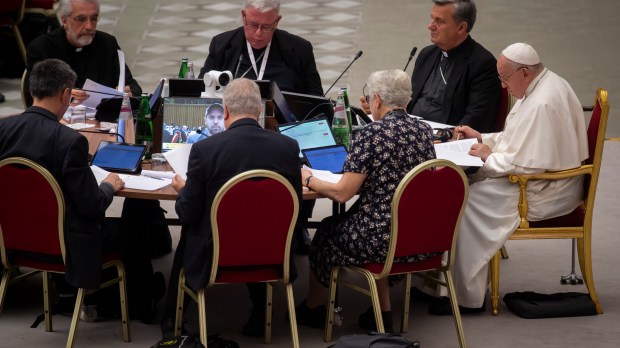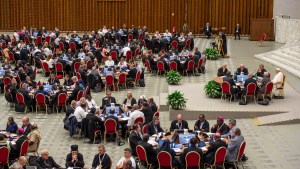On Sunday, October 29, 2023, the Pope will celebrate the closing Mass of the first Roman phase of the Synod on the Future of the Church. Today, the 364 members of this assembly, which includes lay men and women, will vote on an around 40-page summary report, which is intended to specify the points of agreement reached, highlight the questions still to be discussed, and indicate how they would like to continue their work until the next session, in October 2024.
As the first phase of the Synod at the Vatican draws to a close, I.MEDIA takes a look back at some of the main lessons that have emerged during this month of work.
1. A synod on method, not doctrine
The Synod on the future of the Church will not “bring solutions to all problems,” but it will “define a new way” for the Church to tackle them, said Cardinal Fridolin Ambongo, Archbishop of Kinshasa. Like him, many other members of the Synod have repeated this to the press.
Launched in 2021 at local and then continental levels, this major consultation has brought a series of questions to Rome – the working document, which the members have based their discussion on, contains 309 question marks. For some, these questions were simply a “pretext” to “test” the new synodal culture that the Pope intends to implement at all levels of the Church.
For a month, the 365 members – including the Pope – experimented with a method of discernment inspired in part by the Jesuits, called “conversing in the Spirit.” This carefully structured method prioritizes listening, silence, and prayer. Everyone has equal speaking time and can express themselves freely without being criticized head-on.
The shape and table layout chosen for the Paul VI Audience Hall also reflected a desire to establish a principle of equality between members. “There’s no more protocol in the Vatican,” says one member, a little bewildered after finding himself dining close to the Secretary of State of the Holy See, Cardinal Pietro Parolin, at the spiritual retreat held right before the beginning of the works.
This method, criticized by some for its rigidity or its temptation to “canalize the Holy Spirit,” has for others the virtue of forcing opponents to listen to each other in a calm atmosphere. A photo posted on X (formerly Twitter) bears witness to this: that of Jesuit Father James Martin, committed to reaching out to the LGBTQ community, alongside Cardinal Gerhard Müller, former Prefect of the Dicastery for the Doctrine of the Faith and a critic of the Synod.
2. A Synod with varying concerns
Participants were invited to experience this assembly as a spiritual retreat, theoretically detached from all media pressure. At a press briefing, Cardinal Kurt Koch, Prefect of the Dicastery for the Promotion of Christian Unity, explained that at the previous Synod in 2019, dedicated to the Amazon, the Pope had found the discussion“too political and not spiritual and theological enough.” He had heard “many voices, but it wasn’t possible to listen to the voice of the Holy Spirit.” The synodal method does not place itself on a “democratic and political” plain,emphasized the Swiss cardinal.
The conversations, however, took place in the context of current events and developments in society, thus going beyond the simple delineation of a “Synod on Synodality.” Among the most sensitive themes addressed was the issue of ‘LGBTQ+’ communities, with the now commonplace use of this acronym. There was some criticism of the Synod’s overly “Western” tone. Members from Africa and Asia were able to express different expectations and conceptions of synodality.
An Eastern bishop, for example, underlined his country’s exhaustion in the face of the influx of migrants: “The discourse of European Catholic leaders on welcome must take into account the reality of migration throughout the world,” he remarked. In the current context of war in the Holy Land, this bishop would have liked to see the Synod focus on existential questions, such as “war and peace” or “the protection of life from birth to death.”
The role of women, 54 of whom were able to vote for the first time at this Synod, was a central point of discussion at this assembly. The Pope’s only public intervention in the course of the debates concerned the role of women, whom he recalled as pioneers in the transmission of the faith. Referring to an intervention by one of the Synod’s members, Colombian nun Liliana Franco, the Pope denounced the “macho and dictatorial” attitudes of those who overstep their ministry, and end up “mistreating” the people of God and “disfiguring the face of the Church.”
There seems to be a relative consensus on the need for a more incisive presence of the laity, and of women in particular, in the Church, in the name of a principle of ‘co-responsibility’ already at work in some dioceses. At a press conference, Mgr Jean-Marc Eychenne (Grenoble) stressed the importance of women’s participation in episcopal councils. The question of female deacons, more complex in its canonical and historical implications, should also be featured in the summary report, but without necessarily opening up an explicit path towards its adoption.
3. Muted tensions and a crucial issue
The first days of October promised to be stormy for the Synod. On October 2, Pope Francis chose to publish a response to the dubia – or doubts, in Latin – of five cardinals on sensitive topics such as the ordination of women and the blessing of homosexual couples. “It was a skillful way of evacuating the subject by proposing pastoral responses,” notes one observer, who reassured that the Synod members were not obsessed by these subjects during the month of work. At the request of the Pope, the members were also asked to prioritize “silence,” which was generally respected.
Inside Paul VI Hall, however, tensions did arise – the organizers always preferred to use the word “differences.” Among the more reform-minded, some expressed concern at the Church’s inertia over sensitive issues. “It’s a Synod on Synodality, but we can never move forward on ‘form’ alone, we must also be able to move forward on ‘substance’,” said a German-speaking bishop. “The Germans are keeping a low profile in the room, acting more underhand,” a bishop from another country said, aware that the Germans are just emerging from their own synodal journey, where a vast reform plan was voted, but which was repeatedly criticized by various members of the Church and notably, Pope Francis.
The question of the authority of this unprecedented Vatican event continued to be raised throughout the month. In the last week, Cardinal Mario Grech, Secretary General of the Synod, felt the need to reiterate the legitimacy of its composition, while some were still concerned about the presence of women among the members of this institution traditionally made up of bishops.
“The episcopal character of the Assembly does not appear to be compromised by the presence of members not endowed with the episcopal munus,” he insisted, citing Pope Francis’ 2018 constitution Episcopalis communio, which reformed the Synod of Bishops. He highlighted that the presence of lay people in particular – both men and women – formed “the memory of the process of listening and discernment that involved the Holy People of God” since 2021, the year the Synod was launched at local level.
This reminder from Cardinal Grech underlines just how crucial and decisive the question of authority and power in the Church is for the future. It could be summed up as follows: ‘Who decides in the Church, why and how?’ In his impromptu address on Wednesday, the Pope insisted heavily on the need for the Church to move forward with “the holy faithful people of God.” They are “infallible” when they believe, he said.
4. A Synod without “stars”
There was one technical detail that struck all the participants and was repeated over and over again: the famous round tables around which the discussions took place. The Synod was designed to erase hierarchical differences. Cardinals sat next to lay catechists, archbishops next to nuns. And if on the first day, prelates wore their red hats or their purple skullcap, these symbols were soon abandoned for the simple clergyman suit.
In fact, in these exchanges on an equal footing, almost no personalities stood out. Some names did leave a mark, however, as the days went by: French Cardinal Jean-Marc Aveline, who according to several sources was the penman on the “Letter to the People of God” published on October 25, and who is part of the commission overseeing the drafting of the final document. Congolese Cardinal Fridolin Ambongo also made his presence felt. “He is one of the great voices of Africa,” notes one observer, underlining that this continent’s voice was much taken into account at this session.
The Synod’s official preacher, Dominican Father Timothy Radcliffe, provided a daily stimulus for reflection. His meditations, tinged with nuance, depth, and humor, succeeded in rallying the most opposing voices in the assembly, several members said.
Pope Francis was the only one to hold a special place. As the month progressed, the soon-to-be 87-year-old Pontiff was quite present. “He arrives half an hour early in his wheelchair, sits there and is freely accessible,” said one participant halfway through the event. According to our sources, the Pope spoke several times. However, only his speech on October 25, following the reading of the Letter to the People of God, was made public.
5. The time of the world and the time of the Church
This Synod is unprecedented in its form. Inaugurated in 2021 at the local and then continental level, it does not conclude with this first Roman assembly, but is already looking ahead to the second session in October 2024. “Time is greater than space,” the Pope regularly asserts. The organizers have made sure to give participants plenty of time to listen and express themselves. Their work will now continue over the next 11 months back at the local level.
The summary report to be published on Saturday should set the course. One American member confided that he is “looking forward” to taking home the “direct experiences, grounded in reality” that he heard during these four weeks. Cardinal Jean-Marc Aveline, Archbishop of Marseille, stressed that this will be a “time of germination,” during which the members will continue to work.
Another specific feature of this Synod was the “fasting” from public speaking that Pope Francis requested from the members. Although this request was generally respected by the members, it created a sort of moat around Paul VI Hall where the assembly met, with the press briefings organized by the Holy See offering only a summarized and disembodied vision of the internal reflections. “The time of the Synod is not the time of the outside world,” stressed a French bishop, who considered that the press coverage had little influence on the discussions.
“Perhaps the public has the impression that hardly anything is happening,” said Helena Jeppesen-Spuhler, a Swiss member, in an interview with the German press, warning against the Synod being a “mere bubble.”
In a way, this Synod “disappoints, because it’s not a Synod from which anything very concrete will emerge,” points out French canonist and observer Mgr Patrick Valdrini. He believes, however, that the issues addressed by the assembly “are not dealt with for their own sake,” because the primary aim of this “cultural Synod” is, in his view, to change mentalities.


